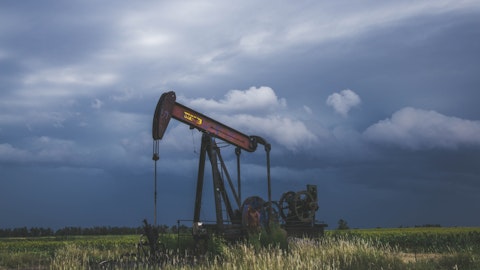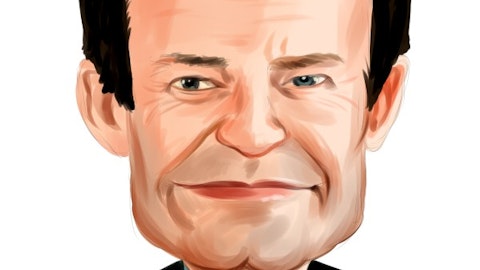I think our traders agree with it. So it’s not 2, but it’s one. So continuing to see demand increase. And again, by the way, what struck me despite the part that some have on the Chinese economy, you said this year, we have plus 2 and again, 70% of it is coming from China. So when China will come back, I read yesterday that the Chinese government is thinking to make an incentive package — macroeconomic incentive package raising more debt in order to give imports to their economy. By the way we complain about the growth in China, which is 5%, and it’s not 1% or 2%. So I think I’m still a believer that Chinese growth will drive again, growth. And in fact, when you look to — by the way, on oil demand, I will give you a clue. It’s not very complex.
You take the last 20 years, you look to the increase of the population of the world, plus 1.2%. You look to the increase of the oil demand until 2019 because you have a — it was exactly plus 1.2%. In fact, the oil demand is not related to GDP, is related to the growing population. Because it is a fundamental factor, and it’s why, by the way, transition will be complex, a growing population because this 1.2% or 1% is still announced for the next 20 years. So 1% on the planet, it requires more energy, better way of increasing their life standard, and that’s more energy. So that’s — so it’s very aligned. You can see that. We will make a presentation soon on our TotalEnergies’ outlook on November 13, and we will explain that again. So that’s the demand.
Refining margins. Refining margin is different. It depends on the market, supply and demand. We’ve seen them going to the roof going 1 or 2 months. During summer time, everything was under constraint. I think you still have, honestly, in this downstream business, an impact on the ban of Russian products because all that has put ocean crude oil on 1 side. So the quality of the crude oil is different in the refining system, and also on the products. You have this organized, I would say, as a transportation. Transportational costs are more expensive. And so today, what we face is that you see — the gasoline demand. The gasoline spread is down, quite low. Because, again, the gasoline demand in Europe is, I think, impacted by the [indiscernible].
You have an elasticity of the demand to the price. So when in the third quarter, you’ve seen $90 per barrel, $95 per barrel plus a strong margin of refining. The customers, when price is high, they save energy. They reduce their consumption. So this is what we have observed. And so today, the gasoline demand is happening. So the spread crack is softening. But the diesel crack is still high, very high, $30. Because there, on this side, you have an impact of the fact that we have less heavy crude. So it’s more expensive to produce diesel. And so you had some warning, which I think are exaggerated from [indiscernible] we might have a lack of diesel, will not have a lack of diesel for sure. You know why? Just because we find our smart people. When you have a strong crack on diesel and a low crack on gasoline, you will adapt your refinery and you make more diesel and less gasoline.
So it’s quite easy business. And we have flexibility. So today, our machines are running to make diesel. And so no fear, but a good benefit. So Yes, it has suffered, but I would say I would expect a margin around $70, $80 per tonne for the next month. It’s a good bet. I would be surprised to see them coming back very low because, again, you have some inefficiencies in the system because of the Russian ban, not only on oil, but also on products, [indiscernible] some, I would say, increased costs. On the wind, yes, wind, European Commission. And it’s more the European wind manufacturing industry, which is complaining, if I’m reading carefully rather than the European wind development industry. The developers are still willing to develop with lowest cost because that’s a good question to the commission, I think.
Like on solar, do they want to protect the consumers by continuing to have access to the lowest possible cost of renewables or do we want to protect the manufacturing industries? That’s a question. Until now, in the last 10 years, it was always EU has favored the consumers, in fact. And I’ve seen a call from the solar developers calling for not protecting them. So we’ll see, again, for us, honestly, at the end of the day, in the U.S., when we are asked by the IRA to use the U.S. goods, we are using U.S. goods. You know in the offshore wind project in New York, we have made a deal with GE. We secured the price and the cost, by the way, of the turbines with GE, which will build a new manufacturing plant in New York, creating local jobs. All that has a cost, but it has been integrated in the CFD, which has been accepted and agreed negotiated.
So I think — so up to — we will adapt ourselves, we are flexible. That’s why, by the way, we should not anticipate too early this type of CFDs in insurance. Because if you take the insurance, it’s too early, when as the enrollment is moving, you could be a trap in something which become less profitable. So it’s — because wind — offshore wind is taking more time. Having said that, at the end of the day, I can confirm to you, but I see more and more gold wind Chinese wind farms being built in Europe and in the world.
Operator: The next question is from Bertrand Hodee of Kepler Chevreux.
Bertrand Hodee: Yes. Two very quick ones, if I may. The first 1 on Namibia, you disclosed at the first DST test. So on was in line with expectation. But can you share a bit more color on that? You’ve hinted that if it was 5,000 barrels of oil equivalent a day was not good. It was 15, it was okay. So can you give us a bit of a color and whether it was above 15 or below 15? That is essentially my question. And then on U.S. offshore wind in New York. Can you disclose in dollar per megawatt what is your current CapEx estimate before any inflation provision?
Patrick Pouyanne: No, I cannot feel your full [indiscernible], sorry to tell you that. I didn’t know that 15 was a threshold. It depends on — honestly, I think we told you the truth. It’s in line with our expectations. That means that it’s in line. We have the assumptions, we have taken to plan the development. So if it’s in line, that means that we are happy. We introduced — we get the data. They confirm the productivity and the production per well. And we know that with this level of production per well, we can make a profitable development. So I don’t want to comment more one test, because we have plenty of tests coming. And so let’s continue the job, and you will have to rely on what we say. But as we are listed companies, generally, we say the truth.
And then on the second one, I think it’s something that I don’t remember, to be honest, so dollar per megawatt hour before any CapEx provision or we don’t work like that. So we have a CapEx, including contingency. This is the way we work to know. We work in offshore wind in the same way, but in oil and gas on our side. We are an experience of our projects, offshore projects. And you know that when you make an offshore project, you don’t stick with only the EPC contract, but you are taking some contingencies. And when we communicate in oil and gas on the CapEx, we communicate it always including contingencies. Because we perfectly know, but in oil and gas, when you make the projects, things will not be exactly the sigma will be EPC contracts.
And this is 1 of the mistakes which is done in this industry by some of the competitors, which believe that you make the EPC, it will execute rightly the EPC. And it’s why today you have some EPC contractors, which are facing difficulties because when they have built pressure on them, and they are obliged to announce losses. Now it’s not a way. If the sustainability of this model — business model, like we’ve done in the oil gas industry is to understand what you make a project because your EPC contractors are also surviving and not just surviving, making profits. And that’s why when we execute a project in oil and gas, we know that we have contingencies. I remember the first time or offshore wind developers came to the Executive Committee were it mentioning to us 2% of provision.
We were losing with it. No, no, offshore, it’s at least 10%. And we know that by experience. And I will tell you that our experience in Seagreen installing 100 wind turbines, offshore is much more complex, but installing 1 big offshore oil platform. So it’s including provision, and we make all our projections and negotiation with the right provision within our CapEx. Thank you.
Operator: The next question is from Paul Cheng of Scotiabank.





